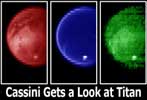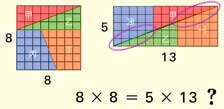|
Archive: October 28, 2004
|
"If it doesn't start with an equal sign, it's wrong"
This is a first for me; spreadsheet nerdliness. But there's a larger point, too. Read on.
Today I was talking with a good friend who is doing some consulting for a small company. In reviewing their revenue projections, he immediately noticed they were in big trouble. Why? Because in their Excel spreadsheet projecting revenue, many of the values did not start with an equal sign.
If you've used Excel you know there are two ways for each spreadsheet cell to have a value. The simplest way is that the cell has an explicit value, you type it in, and whoop, there it is. The other way is that the value is implicit, it is computed from a formula specifying other cells, functions, operators, etc.. Formulas are indicated by a leading equal sign.
As soon as my friend saw the cells without equal signs, he knew there were problems. Revenue projections derived from typed-in numbers cannot be accurate, they are affectionately known as "swags" (semi-wild-ass guesses). Entrepreneurs love swags because they don't have to think, and they can be as optimistic as they want. Accurate revenue projections must be carefully calculated from a whole series of estimates; market size, likely penetration, customers, unit volume, price, etc. These estimates are often swagged themselves, but as much as possible they should be based on hard data. Coming up with hard data is hard, because it requires thought, and work.
Okay, so that's the joke; if you see a spreadsheet with cells that don't start with equal signs, the values are guesses, and they are probably wrong. In fact even if they're right, they're wrong, because guessing is not the way to derive projections.
Here's the larger point - be honest. I don't mean honest as in "don't steal", I mean honest as in "don't kid yourself". If you are operating a business, you have to know what is really happening, and you have to deal with the actual facts. (People who start to believe their own hype are "drinking their own bathwater", which is a perfect simile.) Sure you can invent revenue numbers by typing them in, but doing so won't make it so.
|
|
Wired reports Tivo is removing features to protect their relationship with content providers, who are [apparently] nervous about TivoToGo. The changes allow Tivos to auto-delete Pay Per View and Video On Demand movies. [ via Matt Haughey ] 
Just came across this post from A. Beaujean on GNXP: We the Beautiful: " 
The conclusion that beautiful people are more intelligent follows from four assumptions:
- Men who are more intelligent are more likely to attain higher status than men who are less intelligent.
- Higher-status men are more likely to mate with more beautiful women than lower-status men.
- Intelligence is heritable.
- Beauty is heritable.
If all four assumptions are true, then the conclusion that beautiful people are more intelligent is logically true, making it a proven theorem.
I'm not sure about this logic. I guess this might be true, if you also assume good looking women have good looking sons. Empirically does this hold? Undoubtedly. Check out the girls in a wealthy area.
Kind of related... Do you believe people are getting smarter? The check out this 1885 8th grade test from a Kansas schoolhouse. Now I grant this test primarily is measuring knowledge, not intelligence, but it is thought-provoking even so. [ via Cory Doctorow ] 
 The Cassini spacecraft recently flew within 500 miles of Titan, Saturn's largest moon, and as space.com reports New Images of Titan Baffle Astronomers. Titan is large enough to have an atmosphere, the composition of which adds to the mystery. The Cassini spacecraft recently flew within 500 miles of Titan, Saturn's largest moon, and as space.com reports New Images of Titan Baffle Astronomers. Titan is large enough to have an atmosphere, the composition of which adds to the mystery. 
 I'm strongly considering an iMac G5, maybe a 20". I have one of the original "lamp" iMacs, and although it has been a faithful and wonderful machine, it is a bit dated. (Does run Panther just fine.) One interesting thing about the new iMacs, it is completely user-serviceable. "With its simplified, modular interior, the machine was designed to make it easy for consumers to perform their own repairs. If something goes wrong, Apple dispatches a spare part, and the owner performs the do-it-yourself repair, from swapping out a faulty hard drive to installing a new flat screen." I'm strongly considering an iMac G5, maybe a 20". I have one of the original "lamp" iMacs, and although it has been a faithful and wonderful machine, it is a bit dated. (Does run Panther just fine.) One interesting thing about the new iMacs, it is completely user-serviceable. "With its simplified, modular interior, the machine was designed to make it easy for consumers to perform their own repairs. If something goes wrong, Apple dispatches a spare part, and the owner performs the do-it-yourself repair, from swapping out a faulty hard drive to installing a new flat screen." 
Yesterday we considered some takes on whether Apple will ultimately release a "video iPod". Russell Beattie weighs in: Why Steve Jobs is Wrong. "Steve's going to eat his words on this one just like the 'hell freezing over' thing. I honestly think this is Steve trying to shape consumer opinion because of his ties to the movie industry [Pixar], rather than him listening to what people want or looking towards the future. There's no reason in the world that the iPod can't be an incredible mobile video player and that sitting in its dock become a TiVo-like device as well." Time will tell. 
Meanwhile "broadband video" is gaining traction. WP reports Web TV Start-Ups Show Programs Outside the Box. "Most of the new players are operating on the fringes of the Internet video free-for-all. That's because virtually all the leading cable and satellite companies, along with the movie studios, are rushing to develop their own video-on-demand services." 
 Finally, remember Marc Cantor's interesting equation? Yeah, 64=65. Let's see if we can figure this one out. The area of the red and green triangles is (3*8)/2 = 12, and the area of the blue and orange shapes is (3*5)+(2*5)/2 = 20. So indeed all four add up to 64. So what is happening on the right? Well, the outsides of the shapes definitely form a 5x13 rectangle. But since the areas of the shapes add up to 64, not 65, there is one unit of "space". This occurs along the seams inside the purple ovals in the diagram. These seams appear to have the same slope in the adjacent regions, but they don't really. The slope of the red and green triangles' hypotenuses is 3/8, while the slope of the blue and orange regions is 2/5. These are close (15/40 vs. 16/40) but not the same, leaving a gap of area 1/2 in each purple oval. Finally, remember Marc Cantor's interesting equation? Yeah, 64=65. Let's see if we can figure this one out. The area of the red and green triangles is (3*8)/2 = 12, and the area of the blue and orange shapes is (3*5)+(2*5)/2 = 20. So indeed all four add up to 64. So what is happening on the right? Well, the outsides of the shapes definitely form a 5x13 rectangle. But since the areas of the shapes add up to 64, not 65, there is one unit of "space". This occurs along the seams inside the purple ovals in the diagram. These seams appear to have the same slope in the adjacent regions, but they don't really. The slope of the red and green triangles' hypotenuses is 3/8, while the slope of the blue and orange regions is 2/5. These are close (15/40 vs. 16/40) but not the same, leaving a gap of area 1/2 in each purple oval. 
|
Return to the archive.
|


|




